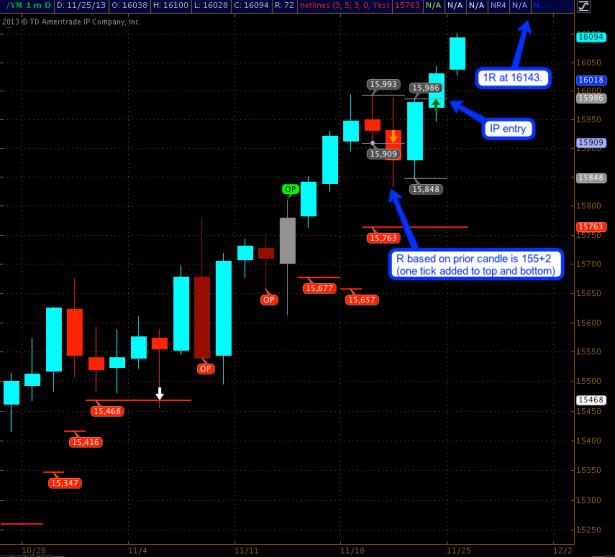Managing Our YM Long Trade
Managing Our YM Long Trade
This is going to be a quick update as I just spent over an hour trying to fix a problem with the Zero indicator. Once again we got graced with one of ThinkOrSwim’s ignominious (a.k.a. unnecessary and new feature laden) updates and apparently it blows up the hourly Zero. The indicator panels won’t show for some reason. Maybe it’s just a new flag cleverly hidden somehow deep below their morass of unintuitive settings. It drives me bonkers and there is a reason I don’t sleep well when TOS announces a new update. Anyway, of course I’m on the case – but I hope Ameritrade’s customer support gets back to me before Christmas.
Many of you have asked me to beef up on the tutorial front. So let’s look at our YM entry last week – how we entered, how we calculated our R size and how we are managing it. For starters the reason for our entry was an inside period (day) on the YM. That permitted us either a long entry above 15,986 or a short below 15848. The way I’m taking these entries is to add 1 tick (or pip in FX) to the top and bottom – those are actually my entry triggers.
Now the inside candle is relative to the prior candle and it is the latter we use for risk calculation. The height of that candle was 155 points and as I’m adding 1 tick each to the top and bottom which gets me to 157. Bear in mind that on the YM one tick equals one handle, unlike on the spoos for instance where one handle equals four ticks. So if we were trading the spoos here we would have to multiply the delta between the top and bottom by four to arrive at our ‘stop-loss in ticks’ value – I hope that’s clear.
For the long trade we now use the 1 tick above the IP trigger as our entry – that also accounts for a bit of slippage. The low of the prior candle becomes our stop – effectively you deduct the stop in ticks from your entry price.
Of course before we take any entries we need to calculate our risk. It’s rather easy to do this via our handy futures risk calculator. All you need to do is to fill out three fields – your account size, your stop loss in ticks (which we already calculated), and the contract you are trading. The example above shows an account of $750k, the stop loss of 157 ticks, and of course I needed to choose the YM from the drop-down. Conveniently everything else is being populated for you – it even shows you the tick size, the point value, and roughly how much margin you can expect for each contract.
Now we press calculate and we are being shown our risk ratio in USD – effectively we are risking 1% of $750k and that comes out to $7,500.-. Of course you can change your risk in the risk ratio field but I would strongly suggest you keep it below 2% – 1% is the norm – we covered this on many occasions here.
Most importantly the calculator shows us how many contracts you can afford – given your account size, the stop loss, and your risk ratio we derive at 9 contracts and approximately $24,750 in margin for this trade. Which means we expect to lose $7,500 or less (i.e. 1R) if we get stopped out. And that is it – all you now have to do is to place your trade, set your stop and you’re good to go.
Moving forward our current system has a few rules we should be aware of. For instance we expect this trade to earn 1R in three candles, including the one we entered in. That means if we have not earned 1R by Tuesday EOD then we should exit. Another rule stipulates that we monitor R multiples. More specifically – if we for instance push above 1R – in this case YM 16143 – during any session but then close the session below it then we need to exit. We do the same for the 2R, the 3R, 4R mark and so on. Also, if we reach an 1R interval and close above it then that 1R interval automatically becomes our new stop. This way we lock in 1R of profit and if we get stopped out the next day and the tape continues to shoot higher afterward – well, that’s just a bitter pill we’ll have to swallow.
So bottom line for anyone who took the YM trade last week:
- We need to close above 16,143 (1R) by Tuesday night EOS.
- If we push above 16,143 (1R) at any time and then close the session below it we need to exit. You can do this a minute ahead or at the very first tick of the night session.
- If we close the session above 16,143 (1R) then we advance our stop to the 1R point.
- If 3 is true then the same rule is repeated with the 2R threshold.
That is pretty much it – I hope this helps you guys plan, enter, and then manage this trade according to the rules.

It’s not too late – learn how to consistently bank coin without news, drama, and all the misinformation. If you are interested in becoming a subscriber then don’t waste time and sign up here. The Zero indicator service also offers access to all Gold posts, so you actually get double the bang for your buck.
Cheers,


















